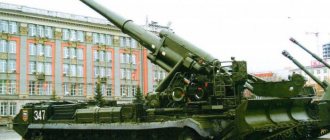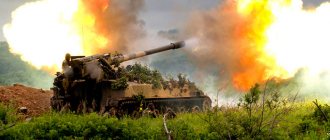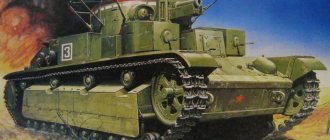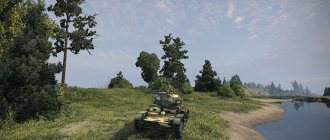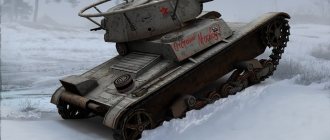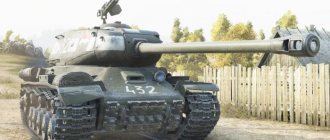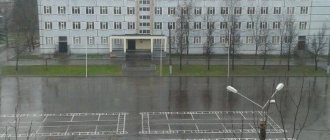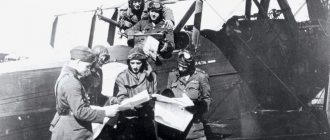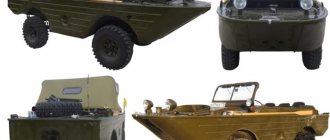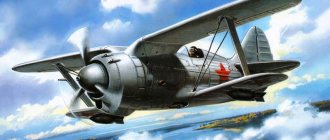The use of artillery in large-scale battles is due to the need to support infantry and tanks. Such cover allows you to slow down the enemy and regroup during defense, as well as facilitate the attack on protected positions.
For a long time, the transportation and deployment of artillery was considered a complex process. The crew was especially vulnerable: bullets, mortar shells and shrapnel could deprive the army of artillery support without even damaging the equipment. The solution to this problem was the development of self-propelled artillery units (SAU).
Self-propelled gun 2S7 "Pion" is one of such developments of the second half of the 20th century. It features good technical characteristics and impressive power. Crew protection, combat performance and mobility have made this weapon relevant to this day.
History of the development of the self-propelled artillery mount "Pion"
Exhibition artillery mount "Pion"
The history of the creation of self-propelled artillery "Pion" is connected with the development of nuclear weapons. By the 1960s, it became clear that global conflict involving nuclear bombs was unlikely. Such a war would almost certainly destroy all its participants.
Taking this aspect into account, the emphasis in the armaments of the opposing powers has shifted towards tactical weapons. Such nuclear charges were supposed to hit exclusively military targets and enemy infrastructure, excluding casualties among the civilian population.
In this context, a new task has ripened before the artillery - defeating the delivery vehicles of the enemy’s tactical nuclear weapons. The need to destroy fortified positions and stationary weapons also remained.
The first projects of new artillery began to appear in the early 1960s. However, Khrushchev was skeptical about barrel weapons, paying attention to missile weapons. Only in the second half of the 60s did active development of a new gun mount begin.
The main requirement put forward by the military for the new self-propelled guns was the destruction of targets at a distance of 25 km. In 1969, the designers of the Kirov plant proposed a 203-mm cannon for this purpose. At the same time, a proposal was received from Volgogradsky to create a self-propelled gun.
In addition to these, several other projects were proposed. For example, the Leningrad Artillery Academy proposed making the gun caliber 210 mm, calculating that it would be the most optimal for the new installation. But the Volgograd plant insisted on 203 mm to ensure continuity of the guns from the B-4 and B-4M guns.
The project to create the Pion self-propelled gun was officially approved on July 8, 1970. The main work on the installation was carried out at Kirovsky, working on the cannon. By 1973, the requirements for the gun were established: non-ricochet shooting up to 35 km, the ability to use 3VB2 nuclear shells and highway speeds from 50 km/h.
By 1974, two prototypes were assembled. During the tests, problems arose with the range of destruction, but they were soon eliminated by a different type of shot and a new composition of the powder charge. The following year, the Pion self-propelled guns were put into service, and in 1977 nuclear weapons were developed for them.
By the mid-1980s, the question of modernizing the artillery installation was raised. The new vehicle received a more powerful V-84B engine, capable of running on diesel, gasoline and kerosene. Some changes affected the chassis, which increased the service life to 8-10 thousand km.
The commander and gunner positions were equipped with additional indicators, which reduced deployment time. The crew was reduced from 7 to 6 people, and the ammunition load increased to eight shells. The new 2S7M self-propelled artillery unit began production in 1986 and was named “Malka”. In documents it may also be designated as “Pion-M”.
Description[edit]
A crew of seven takes 5–6 minutes to engage and 3–5 minutes to disengage. It carries four 203mm rounds for immediate use. It is capable of firing nuclear weapons. The gun's range is 37,500 m, but can be extended to 55,500 m using RAPs (rocket-propelled projectiles). The Pion has been the most powerful conventional artillery piece since it entered service in 1983. An interesting feature of the Pion is the gunfire alarm. Because the weapon's discharge is so powerful—it can physically incapacitate an untrained soldier or crew member near it from the concussion—the Pion is equipped with an audible fire alarm that emits a series of short warning beeps for about five seconds before the charge is fired.
2S7 carries a crew of fourteen; seven are on the Pion and seven are on the auxiliary vehicle. The system carries four rounds of ammunition; Another four shells are carried by the support vehicle. Due to the long range, the crew can fire one or two shots and leave the position before the first shell hits the enemy position at a distance of more than 40 km. This makes the 2S7 less susceptible to counter-battery fire,[1] from enemy counter-battery radars such as the ARTHUR.
Main goals of self-propelled guns
The Pion artillery mount was originally designed for use in both global and local conflicts. The main emphasis was on countering the transportation of tactical nuclear weapons with their subsequent use.
The use of the Pion self-propelled gun is aimed at defeating the enemy in his tactical rear and on supply lines. Ammunition delivery vehicles, fortified facilities, communications centers, headquarters buildings, defensive positions - all of this is hit by artillery at a distance of up to 47 km.
Tactical and technical characteristics allow you to quickly transfer and deploy this artillery. This makes the Pion self-propelled gun in demand both in large battles and in local conflicts.
Installation design
Design diagram of the self-propelled gun "Pion"
The design of the self-propelled gun "Pion" is designed according to a turretless design. The installation consists of a mechanized implement at the rear of the vehicle and the main body. The latter consists of four compartments in which the crew is accommodated during the march.
The control compartment is located in the front, housing the commander, driver and one more soldier. Next comes the engine compartment with the engine, followed by the crew compartment with ammunition and space for four people, including the gunner. At the rear there is a tool and a coulter.
Even during the development process, various chassis options were proposed based on the MT-T tractor and the T-10 tank. However, the available samples were not suitable for artillery firing, as a result of which our own installation was developed. The key condition for its design is maximum unification with the components and components of the tanks in service.
Armored Corps
The body of the self-propelled gun "Pion" is made of external and internal armor with a thickness of 13 mm and 8 mm, respectively. Thanks to this protection, the crew inside the vehicle is protected from bullets and small fragments. The likelihood of using weapons of mass destruction is also taken into account - the body reduces the effect of penetrating radiation by three times.
Self-propelled mortar armament
Firing from the Pion installation
The armament of the artillery installation has the following features:
- a 203 mm caliber gun has a rate of fire of 1.5 rounds per minute, the modified version has a rate of fire of 2.5;
- The gun barrel is collapsible and consists of a free pipe connected to the breech, in which the piston bolt is located;
- together with the recoil devices, the barrel is located in the cradle of the swinging part, mounted on the upper machine;
- anti-recoil devices include a hydraulic brake and two symmetrically located pneumatic knurling devices;
- guidance is provided both by hydraulic drives from the ACS control station and by manually driven mechanisms;
- to speed up reloading, a mechanism is provided that supplies ammunition to the loading level and ensures that it is delivered to the gun chamber;
- there is a folding excavator plate that is buried in the ground and provides stability when firing.
The recoil length when firing is 1400 mm. The lift-and-turn mechanism provides sector fire in the range of 0-60 degrees vertically and from -15 to +15 degrees horizontally. Its own transportable set is 4 ammunition, the 2S7M has 8. Up to 40 ammunition is carried in the transport vehicle. In addition to the cannon, there is a 12.7 mm machine gun with 300 rounds of ammunition.
Engine and transmission
The engine of the self-propelled gun "Pion" V-46-1 is V-shaped, twelve-cylinder, four-stroke, runs on diesel fuel. Liquid cooling, power up to 780 hp. With. Developed on the basis of the T-72 V-46 power plants, a distinctive feature is the changed position of the power take-off shaft.
In the modernized artillery installation, the engine was replaced with a multi-fuel V-84B with a power of 840 hp. With. It has a mechanical transmission with seven forward and one reverse gears, hydraulic control and a planetary steering mechanism.
Surveillance and communications equipment
Terrain surveillance is provided by seven prismatic periscope devices TNPO-160. Two more of these are installed in the hatch covers of the crew compartment. If necessary, some of them are replaced with TVNE-4B night vision devices.
Guidance of the gun is ensured by the PG-1M panoramic sight, which allows artillery fire from closed positions. For firing at observed positions, including direct fire, the OP4M-99A is used.
External communications are provided by the R-123M station. It operates in the VHF band and provides radio communication with similar stations within a range of 28 km, depending on the height of the antennas. Internal communications between the crew are provided by 1B116 equipment.
Howitzer chassis
The chassis of the 2S7 “Pion” self-propelled gun is designed on the basis of the T-80 tank. It consists of seven pairs of double rubber-coated road wheels, as well as six pairs of single support rollers. The guide wheels are located at the rear of the machine, the drive wheels are at the front. The suspension is individual torsion bar and has hydraulic shock absorbers.
In the combat position, the guide wheels are lowered to the ground, which provides better stability when firing. Regulation is carried out by two hydraulic cylinders located along the axes.
Special equipment
Special equipment of the Pion self-propelled gun includes:
- opener in the rear, providing stability when shooting;
- diesel generator 9Р4-6У2 with a capacity of 24 liters. With.
The coulter adjustment is provided by two hydraulic jacks. A diesel generator is designed to work with the hydraulics of a machine when it is parked.
Device
The vehicle was made according to a turretless design, with the gun mounted in the rear. The building itself consists of four compartments.
The control compartment is located at the front, followed by the MTO, then the crew compartment, where the shells and gunner are located, the last compartment is the aft compartment, which houses a folding plate and a cannon.
The body is easily protected by a double layer of bulletproof armor. The crew inside the self-propelled guns is protected by a filter and ventilation unit from weapons of mass destruction.
For loading, there is a lifting mechanism located to the right of the gun.
The B-46-1 engine, running on diesel fuel and developing 750 hp, is responsible for mobility. For autonomous power supply, a low-power diesel engine is provided, developing 24 hp. The transmission is unified with the T-72, the speed on the highway reaches 50 km/h.
The chassis is largely unified with the T-80, has 7 road wheels on each side, and torsion bar suspension.
Ammunition used
Firing from the Pion artillery mount
The Pion artillery mount uses the following types of ammunition:
- high-explosive fragmentation ZOF43 and ZOF44;
- cassette Z-O-14;
- tactical nuclear weapon ZVB2.
The main armament of the 2S7 is high-explosive fragmentation shells, the rest are used according to the situation, depending on the task at hand.
Performance characteristics
The tactical and technical characteristics of the self-propelled gun "Pion" have the following indicators:
- weight - 46 t;
- hull length - 10500 mm, with a gun - 13200 mm;
- width - 3380 mm;
- height - 3000 mm;
- ground clearance - 400 mm;
- gun caliber - 203 mm, rifled, brand - 2A44;
- howitzer ammunition - 4 shells;
- firing range - from 8.4 to 47.5 km;
- rate of fire - 1.5 rounds per minute;
- machine gun - 12.7 mm NSVT;
- engine - diesel V-46-1;
- power - 780 l. With.;
- highway speed - 50 km/h;
- highway range - 675 km;
- fuel tank capacity - 1280 l;
- crew - 7 people.
The performance characteristics of the modernized version have similar characteristics. The main differences are the V84B engine with a power of 840 hp. pp., crew reduced to six people and ammunition increased to 8 shells.
Links[edit]
- ^ a b c "2S7 Pion". Military today. Archived from the original on July 9, 2009. Retrieved January 10, 2010.
- "2S7 Peony". War for Ukraine
. Archived from the original on April 14, 2016. Retrieved April 2, 2016. - “Ağdərə istiqamətində düşmənin artilleriya bölmələrinə zərbələr endirilib” [Enemy artillery units were hit in the direction of Agdara] (press release) (in Azerbaijani). Azərbaycan Respublikası Müdafiə Nazirliyi. September 28, 2022. Retrieved September 29, 2022.
- “Russia: 203-mm self-propelled guns 2S7M Malka destroy targets at 50 km | March 2022 Global Defense Security Industry News | Military security global news industry army 2022 | Archive of news of the year". Archived from the original on January 29, 2019.
- "Russian Armed Forces - Aviation - Navy - Infantry firearms - Communications - Ground systems - Photo gallery of weapons". Archived from the original on July 6, 2013. Retrieved December 24, 2014.
- Jane's Armor and Artillery 1997-98 ISBN 0-7106-1542-6
- sipri.org. Archived from the original on April 23, 2014. Retrieved May 3, 2014.
- "Today.Az." “What weapons did Azerbaijan purchase from Russia last year?” . Archived from the original on December 24, 2014. Retrieved December 24, 2014.
- "Belarusian army equipment". Archived from the original on February 16, 2017. Retrieved September 4, 2022.
- "Georgian Army: Military equipment of the Georgian Ground Forces, Armored vehicles - Pictures". Archived from the original on May 31, 2009. Retrieved February 8 +2016.
- “Artillerymen of the Central Military District in Siberia received the latest self-propelled guns” Malka “”. Archived from the original on June 26, 2022. Retrieved June 26, 2018.
- “Russia is completing the modernization of the 203-mm self-propelled howitzer 2S7M” Malka “| weapons defense industry military equipment UK | focus of analysis army defense industry army".
- “After modernization, the Russian Army will receive one of the most powerful self-propelled guns in the world.”
- "Jane | Latest defense and security news". Janes.com
. Retrieved June 1, 2022. - “Ukraine is returning the most powerful self-propelled guns Pion to service: video”. League. November 10, 2014. Archived from the original on November 11, 2014. Retrieved November 11, 2014.
- ↑
History of the 131st Artillery Division archived March 22, 2013 on the Wayback Machine (in Czech)
Advantages and disadvantages
Compared to domestic and foreign analogues, the Pion self-propelled gun has the following advantages:
- long firing range, which excludes counter-battery fire;
- excellent mobility in deployment and collapse - the installation can leave the position even before the projectile fired at maximum range reaches the target;
- good maneuverability and speed - allow you to transfer artillery depending on the situation.
There are also design advantages. Excavator bipods can burrow into the ground up to 800 mm, improving the stability of the installation. The gun barrel is noted to be disassembled, which makes it possible to change its quickly wearing parts in front-line workshops.
One of the disadvantages is the small azimuth pointing angle, taking into account the strong recoil of the gun. They also note the need to move the vehicle if the firing angle exceeds 30 degrees.
Combat use of self-propelled guns
Despite the long period of operation in the USSR, the Pion self-propelled guns were not used in combat conditions. A large number of installations were part of the Group of Soviet Forces in Germany (GSVG), however, in 1990-91 they were all redeployed to the Siberian and Far Eastern military districts.
There is information about the use of 2S7 installations by the Georgian side during the war in South Ossetia in 2008. A battery of six self-propelled guns was deployed, but they were abandoned during the retreat. One such howitzer installation was taken by Russian troops as a trophy, the rest were destroyed.
This case is the only recorded combat use of the Pion artillery. There is information about the use of installations by Ukraine in the east of the country, however, they do not have documentary evidence. Currently, the 2S7 Pion self-propelled guns are in service with Angola, Azerbaijan, Georgia, Russia, Uzbekistan and Ukraine.
Operators[edit]
Map with 2S7 Pion operators in blue with former operators in red
Although no figures have been made public, it is estimated that more than 1,000 units were built. [6]
- Angola - 12; (Purchased in 2000 in the Czech Republic) [7]
- Azerbaijan - 12; (3 acquired in 2008 and 9 acquired in 2009[8])
- Belarus - 36 in reserve. [9]
- Georgia [1] [10]
- North Korea - unknown
- Russia - 60 2S7M in action. Currently under modernization with new chassis and electronics. [11] [12] [13] [14]
- Slovakia - 3; (1 used for testing, 2 military museum)
- Ukraine - 99, removed from the reserve and restored to the active army due to the war in Donbass. [15]
- Uzbekistan - 48
Former operators[edit]
- Czechoslovakia - 12 vehicles of the 17th Large Caliber Artillery Division in Žamberk, 1984–1994. [16] One vehicle is kept in the Leshany Military Museum.
- Poland - 8 guns. Military designation "Pivonia". Entered service in 1985, withdrawn in 2006. He served first in the 5th Artillery Brigade in Głogów, then in the 23rd Silesian Artillery Brigade in Bolesławiec.
2S7 Pion in the Museum of Technology, Arkhangelskoye, Moscow region
- Soviet Union - Transferred to successor states.
